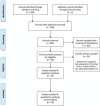Survival of total knee arthroplasty after high tibial osteotomy versus primary total knee arthroplasty: A meta-analysis
- PMID: 31348307
- PMCID: PMC6709048
- DOI: 10.1097/MD.0000000000016609
Survival of total knee arthroplasty after high tibial osteotomy versus primary total knee arthroplasty: A meta-analysis
Abstract
Background: Theoretical considerations suggest that total knee arthroplasty (TKA) is technically more challenging after high tibial osteotomy (HTO), resulting in inferior results compared to primary TKA. However, several studies on this issue have shown contradictory results. The purpose of this meta-analysis to compare survivorship and clinical outcomes between TKA with and without previous HTO.
Methods: We reviewed studies that evaluated pain and function scores, range of motion (ROM), operation time, Insall-Salvati (IS) ratio, complications, and survival rates in patients treated with TKA with previous HTO or with primary TKA with short- to midterm (<10 years) or long-term (>10 years) follow-up.
Results: Fifteen studies were included in the meta-analysis. There were no significant differences between TKA with and without previous HTO in pain score (95% CI: -0.27 to 0.29; P = .94), function score (95% CI: -0.08 to 0.24; P = .32), operation time (95% CI: -5.43 to 26.85; P = .19), IS ratio (95% CI: -0.03 to 0.08; P = .40), complication rates (TKA with previous HTO, 62/1717; primary TKA, 610/31386; OR 1.31, 95% CI: 0.97-1.77; P = .08), and short- to midterm survival rates (TKA with previous HTO, 1860/2009; primary TKA, 37848/38765; OR 0.55, 95% CI: 0.28-1.10; P = .09). Conversely, ROM (95% CI: -7.40 to -1.26; P = .006) and long-term survival rates (TKA with previous HTO, 1426/1523; primary TKA, 29810/31201; OR 0.71, 95% CI: 0.57-0.89; P = .003) were significantly different between the two groups. In addition, both groups had substantial proportions of knees exhibiting short- to midterm survivorship (92.6% by TKA with previous HTO and 97.6% by primary TKA) and long-term survivorship (93.6% by TKA with previous HTO and 95.5% by primary TKA).
Conclusions: This meta-analysis suggests that a previous HTO affected ROM or survival of TKA in the long-term even though both groups have equivalent clinical outcomes and complications. Thus, orthopedic surgeons should offer useful information regarding the advantages and disadvantages of both procedures to patients, and should provide advice on the generally higher risk of revision after TKA with previous HTO at long-term follow-up when counseling patients.
Conflict of interest statement
The authors report no conflicts of interest.
Figures









References
-
- Aglietti P, Buzzi R, Vena LM, et al. High tibial valgus osteotomy for medial gonarthrosis: a 10- to 21-year study. J Knee Surg 2003;16:21–6. - PubMed
-
- Virolainen P, Aro HT. High tibial osteotomy for the treatment of osteoarthritis of the knee: a review of the literature and a meta-analysis of follow-up studies. Arch Orthop Trauma Surg 2004;124:258–61. - PubMed
Publication types
MeSH terms
LinkOut - more resources
Full Text Sources
Medical

